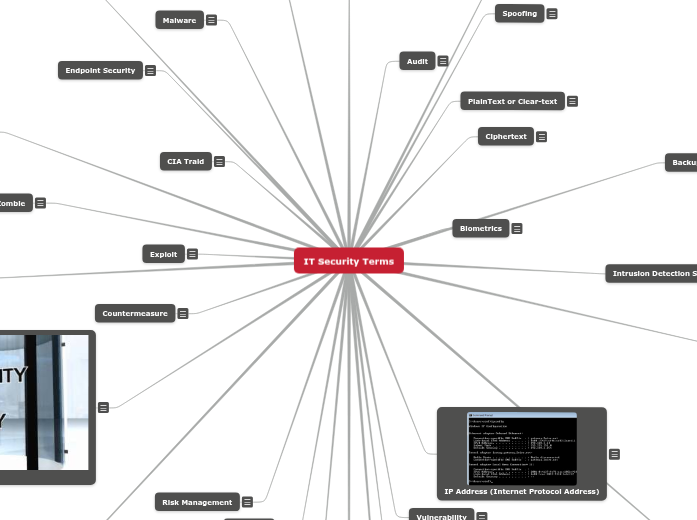IT Security Terms
Router
Router ==> Device that transfers (routes) packets between two or more networks.
Fault tolerance
Fault tolerance ==> the ability of an IS to continue to operate when a failure accurs but usually for a limited time or at reduced level.
Spoofing
Spoofing ==> an attact carried out using a track, disguise, dseit or by faufing data.
Audit
Audit ==> the process of generating, recording, and reviewing a chrolonogical record of system events to ascertain their accurancy.
PlainText or Clear-text
PlainText or Clear-text ==> Readable text
Ciphertext
Ciphertext ==> Encrypted text
Backup
Backup ==> a deplicate copy of data or programs keep it in a secret location.
Biometrics
Biometrics ==> Method of identify a person based on a biological feature, such as a fingerprint.
Intrusion Detection System
Intrusion Detection System (IDS) ==> A defense tool used to monitor network traffic (packets) and provide alerts when there is suspicious traffic, or to quarantine suspicious traffic.
Denial of Service
Denial Of Service (DOS) or Distributed denial of service (DDOS) ==> It is an attact in which a system is bombarded with so many requests (for service or access) that it crashes or cannot respond.
IP Address (Internet Protocol Address)
IP Address ( Internet Protocol Address) ==> An address that uniquely identifies a specific computer or other device on a network.
Vulnerability
Vulnerability ==> Weakness that threatens the confidentiality, integrity, or availability of an asset.
Risk
Risk ==> It is the probability of a threat exploiting a vulnerability.
Botnet
Botnet (Bot Network) ==> A network of hijacked computers that are controlled remotely - typically to launch spam or spyware. Also called software robots. Bot networks are linked to a range of malicious activity, including indentity theft and spam.
Threat
Threat ==> It is Something or someone that may result in harm to an asset
Packet
Packet ==> A Unit of data for transmission over a network with a header containing the source and destination of the packet.
AuthenticationAuth
Authentication ==> Method ( usualy based on username and password ) by which an IS validate or verifies that a user is really who he or she claims to be.
Spywar
Spywar ==> steals software that gothres information about a user or users ionline activity.
Malware
Malware ==> Malicious software, such as a virus, worm, or throjan horse.
Endpoint Security
Endpoint Security ==> Security measure to protect the endpoints, such as desktops and laptos, in the enerprice.
Perimeter Security
Perimeter Security ==> Security measure to ensure that authorized users gain access to the network.
CIA Traid
CIA Traid ( Confidentiality, integrity, availability) ==> The three main principle of IT Security
Zombie
Zombie ==> an effect computrer that effect remotely via internet by an authorized user such as spammer, fraudster or hacker.
Exploit
Exploit ==> A tool or technique that takes advantage of a vulnerability.
Firewall
Firewall ==> A method of (hardware or software) of guarding a private network from a public network (Internet) by analysing data packets entering or exiting it.
Countermeasure
Countermeasure ==> Safeguard implemented to mitigate ( lessen) risk.
Access Control
Access Control ==> It is security feature designed to restrict who has access to a network, IS, or data. Access to resources on a computer is restricted using a logical or physical control designed to protect against unauthorized entry or use.
Risk Management
Risk Management ==> Process of identifying, assessing and reducing risk to an acceptable level.
Exposure
Exposure ==> The estimated cost, loss, or damage that can result if a threat exploits a vulnerability
Encryption
Encryption ==> Transformation Data into scrambled code to protect it from being understood by unauthorized users.
Public Key infrastracture (PKI)
Public Key Infrastracture (PKI) ==> A system to identify and authenticate the sender or reciver of an internet message or transaction.
